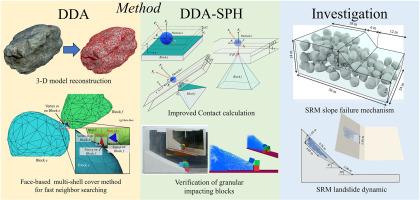Dynamic analysis of soil-rock mixtures based on improved 3-D DDA-SPH method
IF 7.5
1区 工程技术
Q1 ENGINEERING, GEOLOGICAL
International Journal of Rock Mechanics and Mining Sciences
Pub Date : 2025-09-26
DOI:10.1016/j.ijrmms.2025.106286
引用次数: 0
Abstract
Soil-rock mixtures (SRMs) are common in nature and are characterized by strong heterogeneity due to the coexistence of soil and irregular rock blocks. Understanding their complex deformation and failure mechanisms under dynamic conditions remains a major challenge. In this study, a powerful numerical approach is proposed based on the improved three-dimensional coupled Discontinuous Deformation Analysis and Smoothed Particle Hydrodynamics (3-D DDA-SPH) method for analyzing the behavior of SRM slopes in three-dimensional conditions. Key improvements include a face-based multi-shell contact detection algorithm for fast neighbor boundary searching, an advanced contact force model that distinguishes particle-to-face, particle-to-edge, and particle-to-vertex interactions between DDA blocks and SPH particles, and the implementation of a nonlinear softening constitutive model within the SPH module to better capture soil behavior under large deformation. The improved 3-D DDA-SPH method is well validated through theoretical and experimental tests and is applied to the investigation of the effect of block sphericity on the SRM slope failure mechanism and dynamic behavior. The results demonstrate that irregular blocks with low sphericity significantly restrict deformation, localize failure zones, and reduce sliding volumes, whereas spherical blocks have a limited resistance. Moreover, high-sphericity blocks within the SRM exhibit increased rotational motion during landslide events, contributing to a more dispersed deposition pattern compared to blocks with lower sphericity. These findings provide valuable insights into SRM slope behavior and offer practical implications for slope stability assessment and the design of landslide mitigation strategies. The proposed method offers a robust tool for analyzing mixture geomaterials in geotechnical engineering.

基于改进三维DDA-SPH方法的土石混合体动力分析
土石混合体是自然界中常见的一种混合体,由于土壤和不规则岩块的共存,土石混合体具有很强的非均质性。了解它们在动态条件下复杂的变形和破坏机制仍然是一个重大挑战。本文提出了一种基于改进的三维耦合不连续变形分析和光滑颗粒流体力学(3-D - DDA-SPH)方法的强大数值方法来分析SRM边坡在三维条件下的行为。关键改进包括基于人脸的多壳接触检测算法,用于快速邻居边界搜索;一种先进的接触力模型,用于区分DDA块和SPH颗粒之间的颗粒对面、颗粒对边和颗粒对顶点的相互作用;以及SPH模块内的非线性软化本构模型的实现,以更好地捕捉大变形下的土壤行为。通过理论和试验验证了改进的三维DDA-SPH方法的有效性,并应用于块体球度对SRM边坡破坏机理和动力特性的影响研究。结果表明,低球度的不规则块体可以有效地限制变形,局部化破坏区域,减少滑动体积,而球形块体的阻力有限。此外,在滑坡事件中,SRM内的高球度块体表现出更多的旋转运动,与球度较低的块体相比,这有助于形成更分散的沉积模式。这些发现为SRM边坡行为提供了有价值的见解,并为边坡稳定性评估和滑坡缓解策略的设计提供了实际意义。该方法为岩土工程中混合土工材料的分析提供了一个可靠的工具。
本文章由计算机程序翻译,如有差异,请以英文原文为准。
求助全文
约1分钟内获得全文
求助全文
来源期刊
CiteScore
14.00
自引率
5.60%
发文量
196
审稿时长
18 weeks
期刊介绍:
The International Journal of Rock Mechanics and Mining Sciences focuses on original research, new developments, site measurements, and case studies within the fields of rock mechanics and rock engineering. Serving as an international platform, it showcases high-quality papers addressing rock mechanics and the application of its principles and techniques in mining and civil engineering projects situated on or within rock masses. These projects encompass a wide range, including slopes, open-pit mines, quarries, shafts, tunnels, caverns, underground mines, metro systems, dams, hydro-electric stations, geothermal energy, petroleum engineering, and radioactive waste disposal. The journal welcomes submissions on various topics, with particular interest in theoretical advancements, analytical and numerical methods, rock testing, site investigation, and case studies.

 求助内容:
求助内容: 应助结果提醒方式:
应助结果提醒方式:


